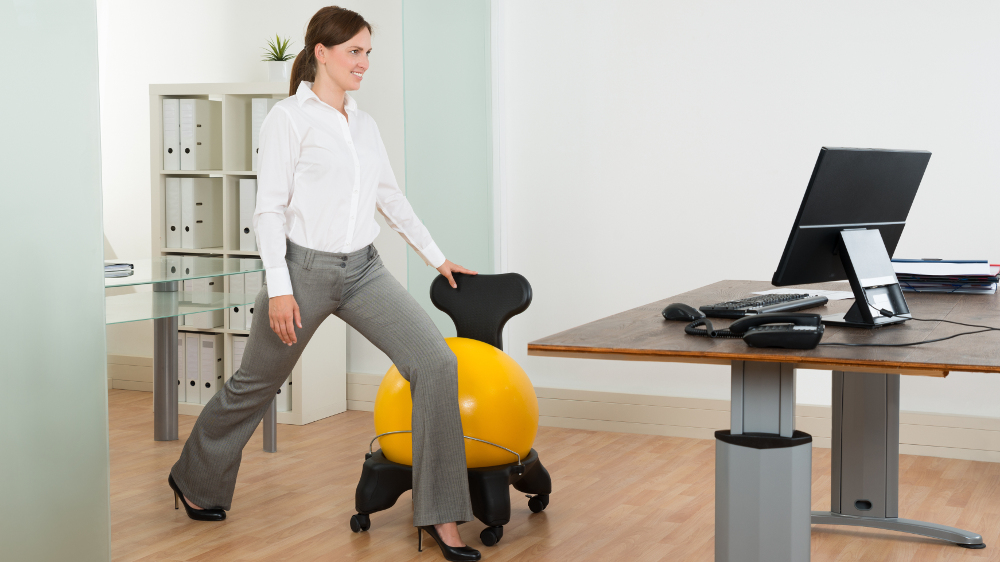Paula Marshall, Head of Furniture Category Sales at business solutions provider Office Depot tells us how the right office fitness furniture can improve employee wellbeing – and have a positive impact on the company’s bottom line.
Fit, healthy and happy employees have been proven to positively impact a business’ operations and bottom line. A recent report, Britain’s Healthiest Workplace (BHW), has found that the most active employees within a business take less time off work for sickness than those who smoke, have a poor diet, or exercise very little. The study also found that employees who lead unhealthy lifestyles are costing British businesses one month per year in lost productivity due to time off sick or under-performance, an act that costs an estimated £73 billion annually.
While the benefit of having active and healthy employees is apparent, encouraging this lifestyle within the workplace can seem a tough task for employers. The sedentary nature of many job roles means that UK workers spend 75% of their day sat down, therefore incorporating physical activity into the nine-to-five working day can be challenging.
Some high-profile businesses, such as tech firm Hootsuite, are attempting to capitalise on the benefits of fitter employees by installing free gyms on their premises. For many other firms, this will not only be financially unviable but it could also prove to be a novelty that is rarely utilised by staff. However, there are alternative solutions such as introducing fitness furniture at the office that not only encourages physical activity but can be used seamlessly throughout the working day, without appearing as a short-lived gimmick.
The workstation
There have been a number of research studies that link excessive time spent sitting to ill health, including a greater risk of cardiovascular disease and Type 2 diabetes. According to guidelines by Public Health England, office workers should spend two to four hours of their working day on their feet to avoid the negative effects of a sedentary lifestyle. With most office workers needing a computer screen to carry out their tasks, encouraging them to step away for four hours is unrealistic. By introducing height-adjustable desks, which can be adjusted between sitting and standing height, workers can stand for the recommended amount of time without jeopardising their workload. In addition to this, standing desks have also been shown to boost energy levels, increase engagement and lessen the aches and pains that can be caused from sitting down for long periods of time.
While height-adjustable desks can be a clever way of encouraging staff to get on their feet more often, it will be managers’ responsibility to motivate employees to use them at first to ensure that it becomes habit. Line managers and team leaders can do this in a number of ways, such as leading by example, allocating time that a whole team should work standing and rewarding those that meet standing targets.
In the boardroom
Meetings are an essential part of office life but many involve sitting down for far too long, adding to health problems as well as causing attention levels to drop. To encourage workers to take the recommended 30-minute meetings and promote physical activity, employers could swap the traditional boardroom table for standing benches or high tables, also known as poseur height. In a similar manner to standing desks, benches and tables provide an alternative to traditional seated settings, helping to aid circulation and boost energy. One benefit of introducing this kind of furniture within the boardroom is that it can be incorporated smoothly, minimising disruption. A combination of high tables, stools, benches and poseur-height swivel chairs encourages employees to either stand or adjust their equipment to their own personal comfort as the meeting progresses. Additionally, by introducing such equipment into the meeting room setting, it ensures that roll-out of equipment across individual workstations is much easier should it be required. As many employees will take part in meetings on a daily basis, it can be a simple and effective way to facilitate non-sedentary work without the need to prompt workers.
Breakout spaces
For informal meeting areas or breakout rooms, employers can provide exercise and stability balls to promote activity during downtime. Sitting on an exercise ball requires small, constant adjustments to postural, leg and abdominal muscles to maintain balance. This improves posture and minimises back pain while also strengthening ab muscles through a low-key workout. By introducing them in breakout areas, businesses will only need to purchase a limited amount, allowing them to save on costs while still providing all staff the opportunity to reap the benefits.
Health and wellbeing initiatives needn’t be costly or difficult for employers to implement. By providing the furniture and means to create an active work environment, businesses can ensure that they will encourage behavioural change, leading to productivity and financial gains.
To find out more about Office Depot, visit officedepot.eu















